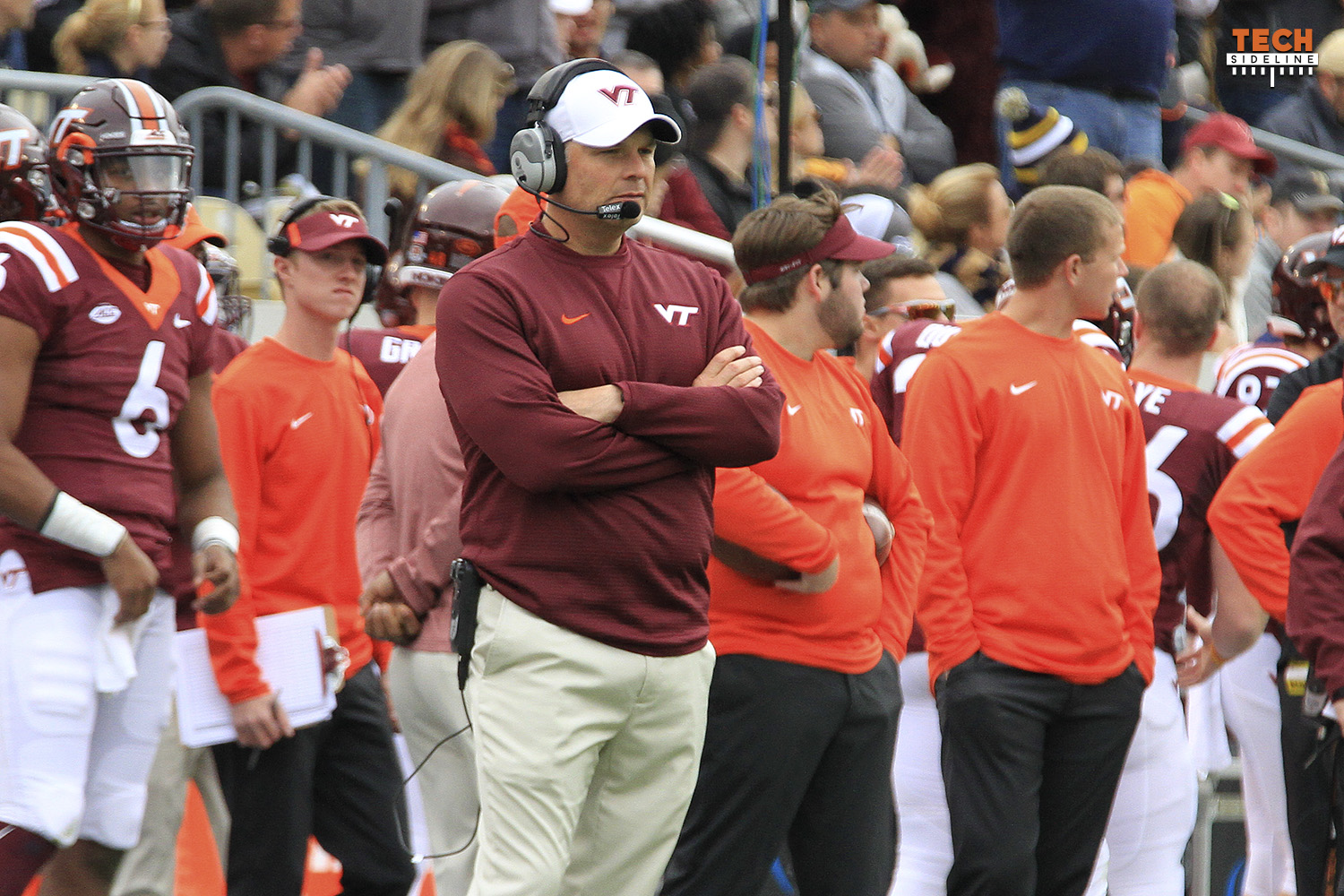Sponsored by the Hokie Club’s Drive for 25: The “Drive for 25” initiative seeks to increase membership in the Hokie Club to 25,000 members in order to provide student-athletes with scholarships for a Virginia Tech education, as well as the resources necessary to compete athletically at the highest levels. Click here to join us today!
When the Drive for 25 was announced on December 12, 2016, there were fewer than 11,000 members of the Hokie Club. We began tracking the numbers a couple of days later using the Drive for 25 website, and as you can see, there has been substantial growth over a full calendar year.
December 14, 2016: 10,609
December 6, 2017: 12,273
(Note: The membership figure peaked at 13,635 at the end of the last Hokie Club giving year, on June 30th, 2017. When the new giving year starts on July 1 and renewals are sent out, the number drops, and it will build to a peak again on June 30, 2018. That’s why you may have seen the number reported in various places appear to drop in recent months.)
That’s an increase of 15.7 percent, which is a good start, but that increase was driven in large part by the new per-seat minimum donations for football and men’s basketball. The Hokie Club got an initial boost in membership from the per-seat minimums which probably won’t be replicated in coming years.
If the Hokie Club reaches 15,000 members by the end of this giving year (June 30, 2018), and then adds another 1,000 new members a year, they would reach their goal of 25,000 members at the end of June, 2028.
Will it happen exactly like that? Maybe, maybe not. I don’t know anything about fundraising, but I assume that you can expect an initial surge because of the newness factor of the program, and then things will level off a bit. Or, maybe they won’t. Maybe things will stay steady at around a thousand new members per year, or perhaps they’ll even go up with a great football season next year. We’ll see.
I’m sure we can expect some new members to drop out this year, especially some new additions from far-away states who can’t take advantage of season ticket benefits. That’s natural. However, new members will continue to be added, and if we use the past experiences of Bill Lansden and Whit Babcock as examples, the overall number of Hokie Club members will continue to grow. Lansden and Babcock are good at this part of the business.
For the Hokie Club priority ticket donation deadline that ended on March 31, 2017, donations for the Hokie Scholarship Fund were up 65%, and total athletic department donations exceeded $30 million for the first time in history. In all, the athletic department took in nearly $33 million in donations. Overall, you can’t ask for a better start to the Drive for 25 campaign.
In fact, overall giving to the university is up as well. According to this article, 35,000 donors contributed to Virginia Tech during the 2016-17 fiscal year. Overall, there was a “62% increase in donations compared to the year before and more than double what was raised two years earlier.” The university took in $162 million, which is very important, considering (according to the article linked above) Virginia Tech is only 17% funded by the state these days. That 62% increase almost exactly mirrors the 65% increase in Hokie Scholarship Fund donations.
That makes sense, considering there have been big changes in University Development over the last couple of years. Charlie Phlegar was hired as Vice President for Advancement at the university level, and Bill Lansden was brought in to run the Hokie Club. Phlegar is a Tech graduate, and previously served as the chief fundraiser for Cornell University. Combine these two hires with Whit Babcock’s strong background in fundraising, and a lot has changed in advancement, both on the university side and in the athletic department.
Ramifications of the New Tax Law on the Drive for 25 and Hokie Club Donations
Many of you are wondering how the new tax legislation that was recently passed by Congress will affect the Drive for 25, Virginia Tech athletics, and college athletics as a whole. If you aren’t familiar with the new legislation, this line from a recent email from the Hokie Club sums it up…
“As you are likely aware, the current IRS code allows for gifts to be 80 percent deductible if giving such a donation provides the right to purchase tickets for seating at athletic events. Under tax legislation passed by Congress this week, the ability to deduct charitable contributions associated with the purchase of tickets would no longer be available, effective January 1, 2018.”
In other words, if you are a Hokie Club member and you use your Hokie Club membership to purchase benefits (i.e., football and basketball season tickets), your donation will no longer be 80% tax deductible. That’s not a big deal for folks who don’t donate a lot of money, but for those who donate multiple thousands of dollars to get good tickets and prime parking spaces, it could potentially have an impact come April 15, 2019.
However, it’s still far too early to assess the potential impact of the new legislation.
“We do believe there will be an effect, but at this time it is too early to predict,” Bill Lansden told TechSideline.com in an email. “We are working with our industry peers to come up with a universal policy on how to counteract the new policy to alleviate as much of the negative effect as possible.”
One of the things the Hokie Club is doing is allowing people to send in their 2019-20 donations early.
“We did send an email to donors indicating we would accept their donation for the 2019-20 season,” Lansden wrote.
Here’s more information from the Hokie Club’s email that Lansden references:
“While the Hokie Scholarship Fund giving deadline for 2018-19 benefits is March 31, 2018, it may be to your advantage to consider making your Hokie Scholarship Fund gift for 2018-19 benefits, and/or pre-paying for future years, prior to the end of this 2017 tax year to guarantee tax-deductibility under current tax law. If you are choosing to pre-pay for future years, please note this in the comments section when making your gift online or in the memo line if you are paying by check.”
Still, that doesn’t answer the long-term question: how will the new tax legislation affect donation levels to Virginia Tech, and all other major college programs? We probably won’t have that answer for several years, but the Hokie Club is working with their “industry peers” to find ways to “counteract the new policy.”
For those who donate to the Hokie Club but receive no benefits from their donation, a plan could be in place that could potentially see them being able to claim a 100% tax write-off.
“For those donating to support Hokie Athletics and our student-athletes by making an annual gift to the Hokie Club, we are working on being able to provide them an option to not accept benefits, thus have a possible 100% tax write-off,” Lansden noted.
In other words, if you are a Hokie Club member from Arizona who donates for the betterment of the athletic department and does not receive the benefits of season tickets, your donation could potentially be 100% deductible in the future. Still, if you’re from Richmond and you receive the benefits of season tickets and a parking pass from your donation, you might be wondering what the future may look like. Unfortunately, the view is still murky.
Another Implication of the New Tax Law: Taxes on High Salaries
Some people think the changes will have a major effect on college athletics, because the new legislation goes beyond removing the law that makes donations 80% tax deductible. According to this article from the USA Today, it will tax major college programs who pay their coaches a lot of money.
This line sums it up best…
“Like other non-profit organizations, colleges will be responsible for paying a 21% excise tax on annual compensation above $1 million that goes to any of the organization’s five most highly compensated employees.”
Here’s an example paragraph from that article…
“Based on pay for the 2017 season, 65 public schools would have faced a combined total of about $30 million in tax just for their football coaches.”

Examples given in the USA Today article: Cincinnati could face up to $500k in new taxes. Iowa State may be paying out up to $700,000 in taxes. Alabama could face a $1.2 million tax for Nick Saban’s $7.125 million salary. Here’s a good quote from Iowa State athletic director Jamie Pollard.
“That figure will have to either be passed on to ticket holders and donors, or taken out of the budgets of sports that are not … being targeted by the federal government,” Pollard said in an e-mail. “It is ironic that the compensation paid in those two sports, by sheer market pressure, will actually now generate an additional financial burden for athletics directors to try and solve in our industry. It will be interesting to watch the new wave of creative ideas and suggestions that will be developed by lawyers, agents and financial advisors, to try and get around the new excise tax.”
All of those numbers come from the USA Today article linked above. It’s good reading, if you are interested in the business of college sports.
In short, athletic directors are going to have to start shelling out more money, while at the same time facing the possibility that they’ll bring in less revenue thanks to donations no longer being 80% tax deductible. It won’t have a huge effect on some of the nation’s bigger programs. Per this USA Today report, Alabama made nearly $19 million in profits in fiscal year 2015-16. Florida made $20 million in profits. Other schools are running easily in the black as well.
It’s different for some other schools that might be breaking even, or perhaps even running in the red. Iowa State made just under $100k in profits in 2015-16, and now they face an additional $700k in taxes. The new legislation could effectively push the Cyclone athletic department from the black into the red. For the first time in years, Virginia Tech ran in the red in 2015-16, with $83.7 million reported revenue and $84.6 million in reported expenses. How will that affect the Hokies in the future? It’s too early to tell.
How much it affects the Hokies depends on the fan base. This is a critical juncture for Virginia Tech athletics, and college athletics in general, and it’s hard to get a feel for how the fan base will respond to new changes. If you’re a Hokie Club member, you can help us get a read on things by choosing an option in the poll below.
[yop_poll id=”43″]
(Note: Will Stewart contributed to this article.)








 Print
Print







Also, the poll results are not showing up on my page
first, I disagree #’s will keep going up … during our heyday weren’t numbers around 13k? maybe 15k max? when we started to become more average those numbers significantly dropped … we are on the upswing again so numbers are creeping back up … that said, I think there is still a ceiling and we wont make 25k anytime soon … I hate to say it, but taxes definitely have an impact on my giving, I need that deduction and if i’m not getting a seat benefit, my dollars are going to shift
I donate to the Hokie Club because I want to support Virginia Tech, not because I get a tax deduction. No change here, and I will increase my giving in 2018.
👏 This right here. I haven’t had season tickets for 3 years now but still give at the same level I used to. I give to support our student athletes. A tax deduction is the least of my concerns and shouldn’t be a motivation to give.
You know – the VTAF could simply automatically allocate all donations associated with seats 80/20 between unique giving silos. Silo #1 would be unrestricted scholarship funds. Silo #2 would be scholarship funds associated with seating priority. Then, reduce the seating tier levels by 80% (Instead of $800 per seat to get the best seating tier, make it $160). So, you still donate $800 to get the best tier, but, $640 goes to silo #1 and $160 to silo #2. One would be required to have all donated amounts either be split 80/20, or, 100% to silo 1 (if no tickets are desired) for this approach to work though.
LOL – I realize it isn’t that simple as some Hokie Club members wouldn’t “get it” and would refuse to allow the automatic allocation, and the IRS would likely shut that approach down in a hurry anyway. But, it makes as much sense as the feds trying to socially engineer individual financial choices via the tax code. It will be interesting to see if any schools take a run at some sort of innovative approach along these lines to test the new rules.
the big donors will simply have the tickets and benefits given to a corporate entity or trust, of which the donor will be an employee.
I did not vote because my wife and I will continue to contribute at our current level. But I have a very bad feeling about how this new tax law will adversely impact donations to all 501(c)3 non-profits (e.g., churches, schools, the Salvation Army …) The standard deduction for a married couple filing jointly will now be $24k.
Shifting to the Drive for 25. It blows my mind that a school with over 250,000 living alumni does not have more than 12,273 active Hokie Club donors. We are so proud of our school that words can not express how much we love the place. It only takes $100. One hundred dollars. We joined up in 1989 and paid the minimum because that is all that we could afford. Now we are at the Platinum level.
Virginia Tech needs you! Become a member of the Hokie Club!
Amen!
We are all talk and no cattle. Homies are cheap
I think the expression is “all hat and no cattle.” 🤣
I donate to the Hokie Club because I want to support Virginia Tech, not because I get a tax deduction. No change here, and I will increase my giving in 2018.
Agreed. I finally signed up and am ashamed for not having done so sooner.
The excise tax on coaches salaries above $1 million may present a constitutional conflict when dealing with public colleges and universities. Most, if not all, public colleges and universities are owned by the states in which they are located and thus are considered governmental units or extensions of the state. The feds historically have not taxed the state with excise taxes as likewise the states have not assessed taxes on the federal govt. This may be the first such law on the books and I would not be surprised to see the constitutionality of the law challenged, perhaps by a state appealing directly to the US Supreme Court.
Very good point. You may see coaches being paid by more than one employer. Also there are many Hokie Club members already getting around the 80% rule and being able to deduct 100%.
Tell me how??
Donors may claim the 100%, but it would not stand up to an audit. I, like the most of the above commenters, will continue with my Platinum giving. However, I think that more direction should be given to those on fixed incomes as to what the financial impact really is based on the preliminary elimination of the 80% rule. The rules will be written and then there will be a period of public comment that will clarify the tax consequences, but the end of the year is fast approaching and decisions need to be made. In this case a benefit is being eliminated in it’s entirety and the impact on individual Hokies is pretty clear.
As a CPA, I am not talking about anything illegal. There are other places to make your contribution.